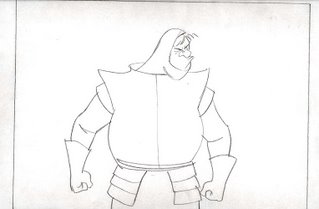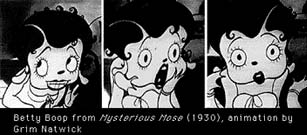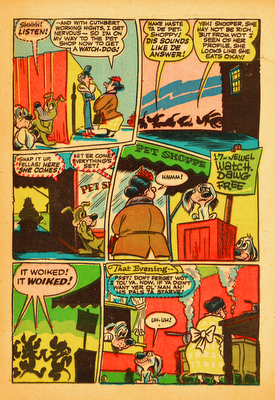There are 3 related terms for artists who draw "Popular" rather than "Fine" art.
Illustrator: an artist who draws mainly "realistic" images that are subordinated to a story, or article. Sometimes the subject matter is fantastic-like Frazetta's. Sometimes it's mundane, like Norman Rockwell.
 Of course, they are designy illustrators too, but my definition mainly means-non-cartoony.
Of course, they are designy illustrators too, but my definition mainly means-non-cartoony.Animator: An artist that moves drawings. During the Golden Age of Cartoons, most animators were cartoonists who learned to move their cartoons. Disney introduced the idea of hiring illustrator types, like Milt Kahl and Marc Davis and taught them to move their less "cartoony" drawings.

Cartoonist: An artist who draws funny and lively and not realistic or designy. This concept started around the turn of the 20th century in newspaper comics and continued in animated cartoons until the 1960s, then died. Now "cartoonist" means someone who can't draw. Witness the current comic strips in the newspaper. Sometimes people call modern animators "cartoonists" and that's wrong too.

During the period from roughly 1920-1950, most animated cartoons were animated in a "cartoony" style. Cartoons were extremely popular mainstream entertainment, so they attracted young cartoonists who wanted to grow up to draw animated cartoons. Most animation then was drawn by cartoonists who as a second thought learned to move them. This produced the greatest age of cartoons.

Both comic strips and animated cartoons inspired funny young kids to want to be "cartoonists", not "animators". The two terms were practically synonymous.
In the 30s, Disney introduced the idea of non-funny animation and hired illustrator types and trained them to animate. "The Illusion of Life" brags about how the original animators like Freddy Moore and Bill Tytla couldn't keep up with the more illustrative type of animation that the feature animators developed in the 1940s. I won't argue the contradictions in this. That's for another post.
These drawings have inspired the Cal Arts style for decades. Everyone is still stealing these expressions, only without the solid construction.

By the 1970s, there were no cartoons in animation anymore. Not on TV and not in the movies.
No one really aspired to grow up to draw the likes of Scooby Doo or Fat Albert. (Actually a couple did, and I wish I had a picture of them to show you.)

People who wanted to be "animators" only had Disney features to look at and really decadent ones at that. This led to the "Cal Arts style".

These are what I call "Cal-Arts expressions". They aren't funny, and they don't reflect any observation of or comment on humanity.
This is a style that is the opposite of cartoony. It's about moving things smoothly and using the poses and expressions you have seen a million times in Disney and Bluth movies. These types of artists don't have cartoonist personalities. They aren't wacky or zany. They aren't hard-bitten sarcastic men who take a grim realistic view of life and then make fun of it in their cartoons.
The Cal Arts style looks like it's drawn by suburban kids who had a normal easy life and don't have anything to say about the world except that their Mom is pear shaped. You see the same stereotypical vacant characters in all their cartoons, whether 2d or 3d. When they get to write their own cartoons, they tend to have scenes where the Mowgli descendants marry their normal bland suburban pear-shaped Moms. (Treasure Planet, Iron Giant).

This character is technically well-drawn by a talented artist, but is not very fun or cartoony and the expressions don't reflect anything identifiable. They are Cal-Arts expressions.
In 25 years of me meeting and hiring Cal Arts students I have only met about 3 or 4 "cartoonists". Aaron Springer, Jim Reardon and Jeff Pidgeon spring to mind. Somehow these guys emerged after 4 years and a hundred thousand dollars wasted with a style of their own and their own unique view of the world.
Cal Arts often rejects super talented cartoonists just because they are cartoonists. Katie Rice and Matt Danner, 2 of the most talented artists and quickest learners I have ever worked with were both rejected on the basis of their portfolios which when they were teenagers were already better than most Cal Arts graduates. Cartooniness is now a crime amongst animation people.
A real cartoonist is a contradiction. It's usually someone who sees life realistically and has a sarcastic view of all the hypocrisy and insanity in the world, yet he (she) draws in a really happy lively, funny style.
Don Martin, Tex Avery, Virgil Partch, Bob Clampett, Grim Natwick, Rod Scribner, Irv Spence, Carlo Vinci, Milt Gross.

Mike Fontanelli, me, Eddie Fitzgerald, Mike Kerr, Nick Cross, Katie Rice, Bob Jaques, Vincent Waller, Jim Smith.

Unfortunately for the very few existing modern cartoonists, there is no cartoon industry anymore. Cartoons are no longer mainstream. Not because the audience doesn't want cartoons, but because the executives don't understand and fear them; cartoons are "written" now by idiots, rather than drawn by funny artists with life experiences and a funny world view to share.
In TV we have fake cartoons, imitation Spumco cartoons or "designy" angled Cal Arts stuff. In features we have Cal Arts CG or we have Dreamworks executive bad taste numbskull CG. No cartoony vision anywhere. Now that they have almost eliminated classic cartoons from television I fear there is nothing to inspire nature's next batch of potential young cartoonists, so they will just find some other field of work to get lost in.
It's ridiculous and criminal, because cartoons are the perfect artform for regular folks. Cartoons are the folk and rock music for the unwashed masses. They are every democratic person's birthright and the modern world won't give people their due.
Cartoons are supposed to be FUN and creative.
DAN GORDON DRAWS FUN
Dan Gordon is a great example of a pure cartoonist. I don't know a heck of a lot about him. He was an animator, storyboard artist (writer) and director for the Fleischers and Famous studios in the 30s and early 40s. He disappears from animated cartoon credits for almost 15 years.
He drew lots of really fun comic books in the 1940s and I collect them.
He has an elusive appeal in his drawings. They aren't perfectly constructed or particularly careful, but the characters all seem really alive and motivated from within. They believe in their little adventures and play their parts with gusto.
A lot of animators in the 40s and 50s drew comic books on the side and it's really interesting to see how they drew when they didn't have to conform to the studio style or the director's style.http://kinky-boot-beast.blogspot.com/2006/12/comic-book-scans.html
Ken Hultgren drew well and perfectly professionally and in a similar style to Dan Gordon's but it lacks the pure fun element in Dan's comics. It's like an illustrator who has been taught to draw cartoons for a living. Chuck Jones' animators drew comics and they are somewhat bland by comparison.
A HANDSOME PAGE FROM A KEN HULTGREN COMIC

A HANDSOME PAGE FROM A KEN HULTGREN COMIC
Anyway, here's Dan-as pure a cartoonist who ever held a pencil. This is a guy who is nice to kids.

Thanks to my pal, Tara, who gave me this comic!
http://kinky-boot-beast.blogspot.com/2006/12/giggle-december-1943.html




 Here's more Dan Gordon from Kent Butterworth's collection!
Here's more Dan Gordon from Kent Butterworth's collection!http://potulentpalaver.blogspot.com/2007/01/john-k-wrote-about-dan-gordon-today-so.html
Dan later became one of the key creative founders of Hanna Barbera's TV cartoon studio. I have seen a few of his storyboard panels and his drawings of Ed Benedict's characters are great. Stylish and sooo cartoony and fun to look at.
If anyone has any, PLEASE post them and I will link to you!


